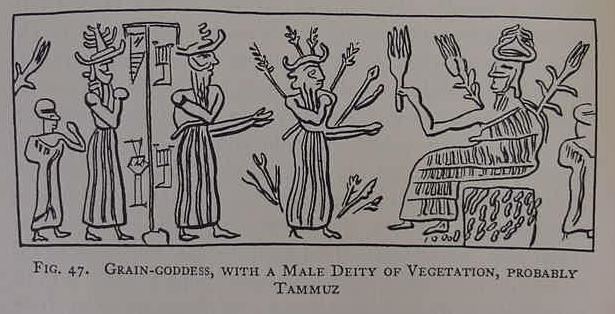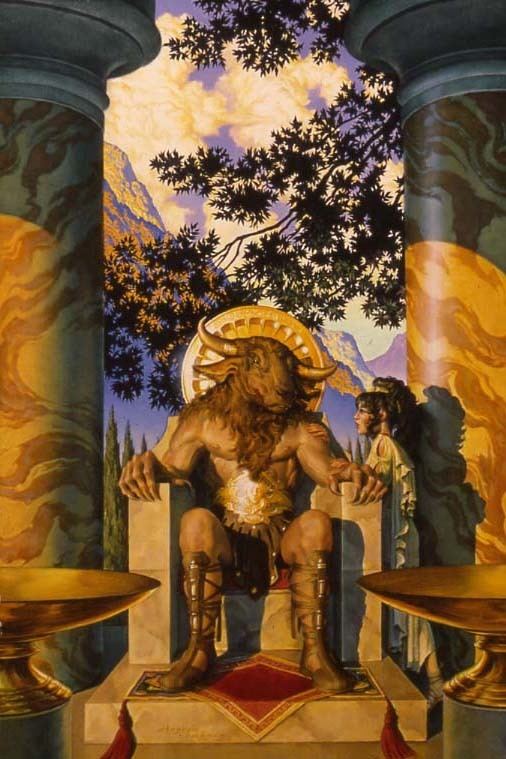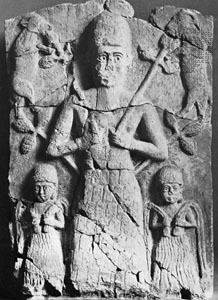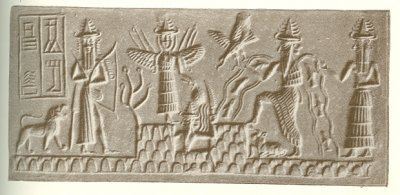 | ||
Similar Semiramis, Enkidu, Humbaba, Utnapishtim, Ninazu | ||
Tammuz (Syriac: ܬܡܘܙ; Hebrew: תַּמּוּז, Transliterated Hebrew: Tammuz, Tiberian Hebrew: Tammûz; Arabic: تمّوز Tammūz; Akkadian: Duʾzu, Dūzu; Sumerian: Dumuzid (DUMU.ZI(D), "faithful or true son") is a Sumerian god of food and vegetation, also worshiped in the later Mesopotamian states of Akkad, Assyria and Babylonia.
Contents
- Ritual mourning
- Tammuz in the Hebrew Bible
- Dumuzid in the Sumerian king list
- Dumuzid and Inanna
- The Courtship of Inanna and Dumuzi
- Church of the Nativity and Shrine of Adonis Tammuz
- Performances
- References

Ritual mourning

In Babylonia, the month Tammuz was established in honor of the eponymous god Tammuz, who originated as a Sumerian shepherd-god, Dumuzid or Dumuzi, the consort of Inanna and, in his Akkadian form, the parallel consort of Ishtar. The Levantine ("lord") Adonis, who was drawn into the Greek pantheon, was considered by Joseph Campbell among others to be another counterpart of Tammuz, son and consort. The Aramaic name "Tammuz" seems to have been derived from the Akkadian form Tammuzi, based on early Sumerian Damu-zid. The later standard Sumerian form, Dumu-zid, in turn became Dumuzi in Akkadian. Tamuzi also is Dumuzid or Dumuzi.
Beginning with the summer solstice came a time of mourning in the Ancient Near East, as in the Aegean: the Babylonians marked the decline in daylight hours and the onset of killing summer heat and drought with a six-day "funeral" for the god. Recent discoveries reconfirm him as an annual life-death-rebirth deity: tablets discovered in 1963 show that Dumuzi was in fact consigned to the Underworld himself, in order to secure Inanna's release, though the recovered final line reveals that he is to revive for six months of each year (see below).

In cult practice, the dead Tammuz was widely mourned in the Ancient Near East. Locations associated in antiquity with the site of his death include both Harran and Byblos, among others. A Sumerian tablet from Nippur (Ni 4486) reads:

Tammuz in the Hebrew Bible

These mourning ceremonies were observed at the door of the Temple in Jerusalem in a vision the Israelite prophet Ezekiel was given, which serves as a Biblical prophecy which expresses the Lord's message at His people's apostate worship of idols:

Tammuz idol worship was inconsistent with Yahwism.
Ezekiel's testimony is the only direct mention of Tammuz in the Hebrew Bible, though echoes of Tammuz have been seen in the Book of Isaiah and the Book of Daniel.
Dumuzid in the Sumerian king list
In the Sumerian king list two kings named Dumuzi appear:
Other Sumerian texts showed that kings were to be married to Inanna in a sacred marriage, for example a hymn that describes the sacred marriage of King Iddid-Dagan (ca 1900 BCE).
Dumuzid and Inanna
Today several versions of the Sumerian death of Dumuzi have been recovered, "Inanna's Descent to the Underworld", "Dumuzi's dream" and "Dumuzi and the galla", as well as a tablet separately recounting Dumuzi's death, mourned by holy Inanna, and his noble sister Geštinanna, and even his dog and the lambs and kids in his fold; Dumuzi himself is weeping at the hard fate in store for him, after he had walked among men, and the cruel galla of the Underworld seize him.
A number of pastoral poems and songs relate the love affair of Inanna and Dumuzid the shepherd. A text recovered in 1963 recounts "The Courtship of Inanna and Dumuzi" in terms that are tender and frankly erotic.
According to the myth of Inanna's descent to the underworld, represented in parallel Sumerian and Akkadian tablets, Inanna (Ishtar in the Akkadian texts) set off for the netherworld, or Kur, which was ruled by her sister Ereshkigal. Ereshkigal is in mourning at the death of her consort, Gugalanna (The Wild Bull of Heaven Sumerian Gu = Bull, Gal = Great, An = Heaven). She passed through seven gates and at each one was required to leave a garment or an ornament so that when she had passed through the seventh gate she was a simple woman, entirely naked. Despite warnings about her presumption, she did not turn back but dared to sit herself down on Ereshkigal's throne. Immediately the Anunnaki of the underworld judged her, gazed at her with the eyes of death, and she became a corpse, hung up on a meathook.
Based on the incomplete texts as first found, it was assumed that Ishtar/Inanna's descent into Kur occurred after the death of Tammuz/Dumuzid rather than before and that her purpose was to rescue Tammuz/Dumuzid. This is the familiar form of the myth as it appeared in M. Jastrow's Descent of the Goddess Ishtar into the Lower World, 1915, widely available on the Internet. New texts uncovered in 1963 filled in the story in quite another fashion, showing that Dumuzi was in fact consigned to the Underworld himself, in order to secure Inanna's release.
Inanna's faithful servant attempted to get help from the other gods but only wise Enki/Ea responded. The details of Enki/Ea's plan differ slightly in the two surviving accounts, but in the end, Inanna/Ishtar was resurrected. However, a "conservation of souls" law required her to find a replacement for herself in Kur. She went from one god to another, but each one pleaded with her and she had not the heart to go through with it until she found Dumuzid/Tammuz richly dressed and on her throne. Inanna/Ishtar immediately set her accompanying demons on Dumuzid/Tammuz. At this point the Akkadian text fails as Tammuz' sister Belili, introduced for the first time, strips herself of her jewelry in mourning but claims that Tammuz and the dead will come back.
There is some confusion here. The name Belili occurs in one of the Sumerian texts also, but it is not the name of Dumuzid's sister who is there named Geshtinana, but is the name of an old woman whom another text calls Bilulu.
In any case, the Sumerian texts relate how Dumuzid fled to his sister Geshtinana who attempted to hide him but who could not in the end stand up to the demons. Dumuzid has two close calls until the demons finally catch up with him under the supposed protection of this old woman called Bilulu or Belili and then they take him. However Inanna repents.
Inanna seeks vengeance on Bilulu, on Bilulu's murderous son G̃irg̃ire and on G̃irg̃ire's consort Shirru "of the haunted desert, no-one's child and no-one's friend". Inanna changes Bilulu into a waterskin and G̃irg̃ire into a protective god of the desert while Shirru is assigned to watch always that the proper rites are performed for protection against the hazards of the desert.
Finally, Inanna relents and changes her decree thereby restoring her husband Dumuzi to life; an arrangement is made by which Geshtinana will take Dumuzid's place in Kur for six months of the year: "You (Dumuzi), half the year. Your sister (Geštinanna), half the year!" This newly recovered final line upset Samuel Noah Kramer's former interpretation, as he allowed: "my conclusion that Dumuzi dies and "stays dead" forever (cf e.g. Mythologies of the Ancient World p. 10) was quite erroneous: Dumuzi according to the Sumerian mythographers rises from the dead annually and, after staying on earth for half the year, descends to the Nether World for the other half".
The "Courtship of Inanna and Dumuzi"
Aside from this extended epic "The Descent of Inanna," a previously unknown "Courtship of Inanna and Dumuzi" was first translated into English and annotated by Sumerian scholar Samuel Noah Kramer and folklorist Diane Wolkstein working in tandem, and published in 1983. In this tale Inanna's lover, the shepherd-king Dumuzi, brought a wedding gift of milk in pails, yoked across his shoulders.
The myth of Inanna and Dumuzi formed the subject of a Lindisfarne Symposium, published as The Story of Inanna and Dumuzi: From Folk-Tale to Civilized Literature: A Lindisfarne Symposium, (William Irwin Thompson, editor, 1995).
Church of the Nativity and Shrine of Adonis-Tammuz
According to some scholars, the Church of the Nativity in Bethlehem is built over a cave that was originally a shrine to Adonis-Tammuz.
The Church Father Jerome, who died in Bethlehem in 420, reports in addition that the holy cave was at one point consecrated by the heathen to the worship of Adonis, and a pleasant sacred grove planted before it, to wipe out the memory of Jesus. Some modern mythologists, however, reverse the supposition, insisting that the cult of Adonis-Tammuz originated the shrine and that it was the Christians who took it over, substituting the worship of their own God.
Performances
A performance of Inanna's descent to the Underworld was organised in 2001 at the Cove in Denmark, Western Australia, and it has also been used by Jean Houston as a part of her Mystery School work.
